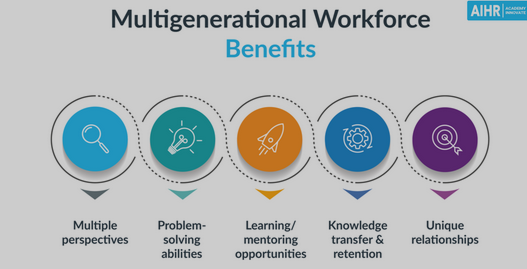Intergenerational communication in the workplace refers to interactions and exchanges between individuals of different age groups. As workplaces increasingly become more diverse in terms of age, understanding how to navigate and enhance communication between different generations is crucial for promoting collaboration and productivity. Here are some key considerations for effective intergenerational communication:

Recognize and Value Differences:
Acknowledge and appreciate the diverse perspectives, work styles, and communication preferences that each generation brings to the workplace.
Avoid making assumptions or stereotypes based on age and recognize the uniqueness of each individual.
Create a Culture of Inclusivity:
Foster a workplace culture that values contributions from employees of all ages.
Encourage open dialogue, where individuals feel comfortable expressing their ideas, concerns, and perspectives.
Flexible Communication Styles:
Recognize that different generations may have varying preferences for communication styles. Some may prefer face-to-face interactions, while others may prefer digital communication.
Be flexible in adapting communication methods to suit the preferences of team members from different age groups.
Mentorship Programs:
Establish mentorship programs that encourage knowledge transfer between generations. Younger employees can benefit from the experience of older colleagues, while older employees can gain insights into new technologies and trends.
Encourage reverse mentoring, where younger employees mentor their older counterparts in areas such as technology or social media.
Effective Use of Technology:
Leverage technology to facilitate communication, recognizing that younger generations may be more comfortable with digital platforms.
Provide training and support for older employees to enhance their digital literacy and ease their adoption of new technologies.
Clarify Expectations:
Clearly communicate expectations regarding work processes, deadlines, and project management to ensure understanding across generations.
Address any potential misunderstandings or conflicts promptly and constructively.
Promote Collaboration:
Create opportunities for intergenerational collaboration on projects and initiatives.
Encourage team-building activities that facilitate connections between different age groups, fostering a sense of unity and shared goals.
Training on Generational Differences:
Offer training programs that raise awareness of generational differences in communication styles, work habits, and expectations.
Provide guidance on how to navigate and appreciate these differences to enhance teamwork.
Respect for Experience:
Show respect for the experience and knowledge that older employees bring to the workplace.
Recognize and celebrate the achievements of individuals at all career stages.
Promote Continuous Learning:
Encourage a culture of continuous learning where employees of all ages are motivated to acquire new skills and stay updated on industry trends.
Provide opportunities for professional development and training for employees at all career stages.
Flexible Work Arrangements:
Recognize that different generations may have varying preferences for work arrangements. Some may value flexible schedules, remote work options, or alternative work arrangements.
Establish policies that accommodate a range of work preferences, promoting work-life balance.
By fostering a workplace culture that values diversity and promotes effective communication across generations, organizations can leverage the strengths of employees at different career stages and create a more dynamic and collaborative work environment.
